常见技巧
本页面记载一些常用的技巧(有待完善)
由于本页面内容较杂,所以加入目录
目录
IO优化
众所周知,在某些数据结构题当中,IO量极大。而输入和输出有需要一定的时间。这个时候,我们的程序运行起来就会出现如下的情况:
所以这时候,我们就需要一个叫做IO优化的东西。(OI需要IO优化)
(限于作者水平,本文仅讲述当下被称作“龟速快读”的OI优化)
读入优化:
原理:getchar()函数的效率相对较高
代码:
int get() {
int x = 0, f = -1; char c = getchar();
while(!isdigit(c)) { if(c == '-') f = -1; c = getchar(); }
while(isdigit(c)) { x = x * 10 + c - '0'; c = getchar(); }
return x * f;
}解释:
!isdigit()表示不是数位)当然前面的int可以换成template<typename T>这类东西
我们在对它进行一些更改,使得它能够读入实数
double getlf(){
double x = 0, y = 1.0; int f = 1; char c = getchar();
while(!isdigit(c)) { if(c == '-') f = -1; c = getchar(); }
while(isdigit(c)) { x = x * 10 + c - '0'; c = getchar(); }
if(c != '.') return x * f;
c=getchar();
while(isdigit(c)) { x += (y /= 10) * (c - '0'); c = getchar(); }
return x * f;
}注意第五行不能省去,因为如果给出一组这样的数据:1 2,会被读成1.2
输出优化:
警告:这里可能是负优化!
原理:同样,putchar比其他函数更快
代码:
void write(int x)
{
if(x<0) putchar('-'),x=-x;
if(x>9) write(x/10);
putchar(x%10+'0');
}这个是用递归实现的。流程大概如下:
- 有一个数1234需要输出:
- 目前的范围:[1234]
- 下一层调用:[123]4
- 下一层调用:[12]34
- 下一层调用:[1]234,此时的x=1,已经小于9了,所以输出'1'
- 返回上一层:输出'2'
- 以此类推,输出'3','4',合起来就是1234了,输出完毕
输出实数太毒瘤了,所以这里就不写了
对拍
在OI中,我们常常需要将正解和暴力优势互补,暴力慢,正解的正确性有时懒得证,于是我们干脆直接将它们对比。
但是
一组一组手敲数据真的慢,还不一定查得出来
所以,我们就需要对拍
对拍四要素:
- 正解
- 暴力
- 数据生成器
- 对拍器
正解、暴力根据题目。
数据生成器:根据题目要求随机生成数据。但是可能造不出HACK数据
对拍器:将两个程序对比的机器。它的流程为:
- 生成一组数据
- 正解、暴力算结果
- 对比,判断是否一样
- 重复执行以上过程直到出错
这就要依靠<windows.h>库中的system()函数。
代码:
#include<iostream>
#include<windows.h>
using namespace std;
int main()
{
while(1)
{
system("数据生成器.exe > data.txt");
system("正解.exe < data.txt > yours.txt");
system("暴力.exe < data.txt > expected.txt");
if(system("fc expected.txt yours.txt")) break;
}
cout<<"发现错误,请查看!"<<endl;
system("pause");
return 0;
}
例如我们要检查\(\text{BigInt A+B}\)的正确性。
数据生成器:
#include<iostream>
#include<bits/stdc++.h>
using namespace std;
int main()
{
srand(time(NULL));
int a=rand();
int b=rand();
cout<<(int)a<<" "<<(int)b;
}
两个程序:
#include<iostream>
using namespace std;
int main()
{
int a,b;
cin>>a>>b;
cout<<a+b<<endl;
}
大整数程序略对拍器:
#include<iostream>
#include<windows.h>
using namespace std;
int main()
{
int T=0;
while(1)
{
T++;
cout<<"testdata<"<<T<<">"<<endl;
system("datamaker.exe > data.txt");
system("A+B.exe < data.txt > yours.txt");
system("A+B_1.exe < data.txt > expected.txt");
if(system("fc expected.txt yours.txt")) return 0;
}
return 0;
}
如果没有错,运行下来是这样的:

我们把BigInt的输出改为:cout<<a+b+rand()%2;
考验rp的时候到了。

事实证明我还是太非了,才五组就挂了。
如何卡常
答:“我不会。”
这部分有待补充